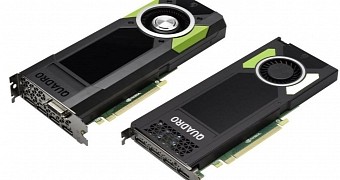NVIDIA has silently introduced two new professional graphics cards, the Quadro M4000 and the Quadro M5000, which are powered by the now famous and successful "Maxwell" architecture also found on the GTX 980Ti.
The new cards from NVIDIA promise to bring strong performance in graphically intensive applications, powered by the GM204 and enjoying 1664 stream processors for the Quadro M4000 and 2048 for the M5000. Both graphics cards feature 256-bit memory bus and hold 8GB of GDDR5 memory.
The slightly more advanced Quadro M5000 has ECC memory and dual-slot cooling system, while the Quadro M4000 offers a more energy-efficient single-slot cooler.
As all professional graphics cards, the new Quadros fully support most application programming interfaces and graphical applications that include OpenCL 1.2, DirectX 12, OpenGL 4.5, 3D Vision Pro, and many others.
However, there are issues with the new "Maxwell" GPU. The new architecture does not have the FP64 arithmetic logic units feature, therefore, the performance of the GPUs based on Nvidia's latest technology for programs that require double precision computing is very low. The FP64 is a common feature that runs on applications used by creative professionals, graphic designers and video editors.
The two are great, with one major problem
Although not being used by programs outside the creative professions, the new graphics adapters will certainly be skipped by these professionals, as they'll prefer to stick with their latest MacPros and AMD's latest FirePro. If they still choose to stick with NVIDIA, though, older "Kepler" units might still do the trick very well until NVIDIA brings the FP64 back.
Unfortunately, performance-wise, the new NVIDIA cards pale when compared to the latest professional graphics card from AMD, the FirePro S9170, which comes with 512-bit memory interface and 32GB of GDDR5 memory and offers 5.24 TFLOPS single point.
Considering such fierce competition from AMD and its widespread presence among Apple-using creatives, the fact that NVIDIA did not include the FP64 arithmetic logic units in its latest product looks like a naive decision, or maybe it’s the company’s way of simply admitting defeat against AMD on the professional graphics cards market.

 14 DAY TRIAL //
14 DAY TRIAL //